Have you ever wondered how Amazon became the e-commerce giant it is today?
A big part of its success comes from its unique approach to product development.
Unlike most companies, which start with a product idea and build forward, Amazon begins with the customer’s needs and builds backward. This is aptly called “working backwards.”
Amazon has used the working backwards method to create industry-defining products, including Kindle, Alexa, and Amazon Web Services (AWS). As a product manager or developer, you can use this methodology to help you build products users truly value.
This article sheds light on the Amazon working backwards method, including how it works, its pros and cons, and a step-by-step approach on how to write your own press release using this method (with a template).
What is Amazon’s working backwards method?
The Amazon working backwards method is a product development strategy where you draft an internal press release before creating the product so that you better meet customer needs.
Also called the “PR FAQ” method, Amazon uses the working backwards approach to envision final products and prioritize their benefits over their features. The company has found that prioritizing customers’ primary needs is more effective than incrementally improving the product until its value is revealed.
Ian McAllister (former Head of Products) initially leaked the method in a Quora thread. However, current Amazon executives Bill Carr and Colin Bryar have since written about it in a book.
Considering that Jeff Bezos started with a basic MVP and used a few simple steps to expand, the working backwards method is clearly powerful.
Here’s what Amazon's first homepage (the OG MVP) looked like:
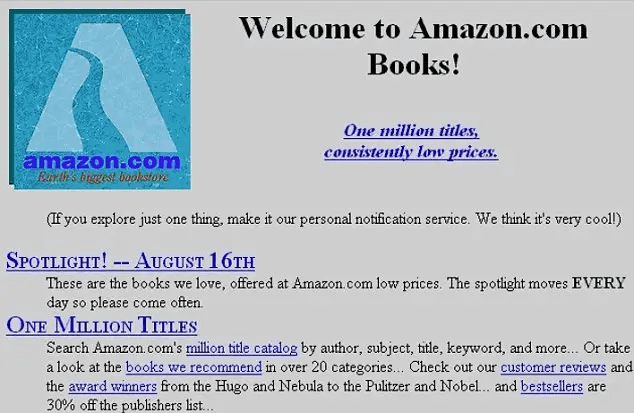
Companies that use other methods to try and improve or adapt until they meet the demands of their target market often struggle.
The Waterfall methodology, for instance, wastes too many resources defining plans that sometimes don’t align with customer needs. And the Agile method still requires you to test based on response or to iterate until you meet customers’ needs.
The PRINCE2 approach might work well in theory due to having spikes that help to cut out uncertainty, but it, too, can’t keep up with the efficiency of the working backwards approach.
What are the benefits and limitations of Amazon working backwards?
Despite its promise, the working backwards method might not be right for every company, niche, or product. To help you decide if it’ll work for you, let’s go over some of its benefits and drawbacks.
The benefits of working backwards
The working backwards approach forces a product team to view the product from the perspective of a customer — focusing more on the “why” instead of just the “how.” This can help the team assess its viability (and cut out any gut feelings or biases).
This approach can also assist in determining market or customer fit. For example, if the press release is difficult to write, then the product will likely not be well-received.
Writing a press release is also a more efficient and simpler task than developing a minimum viable product or conducting multiple customer surveys during product discovery.
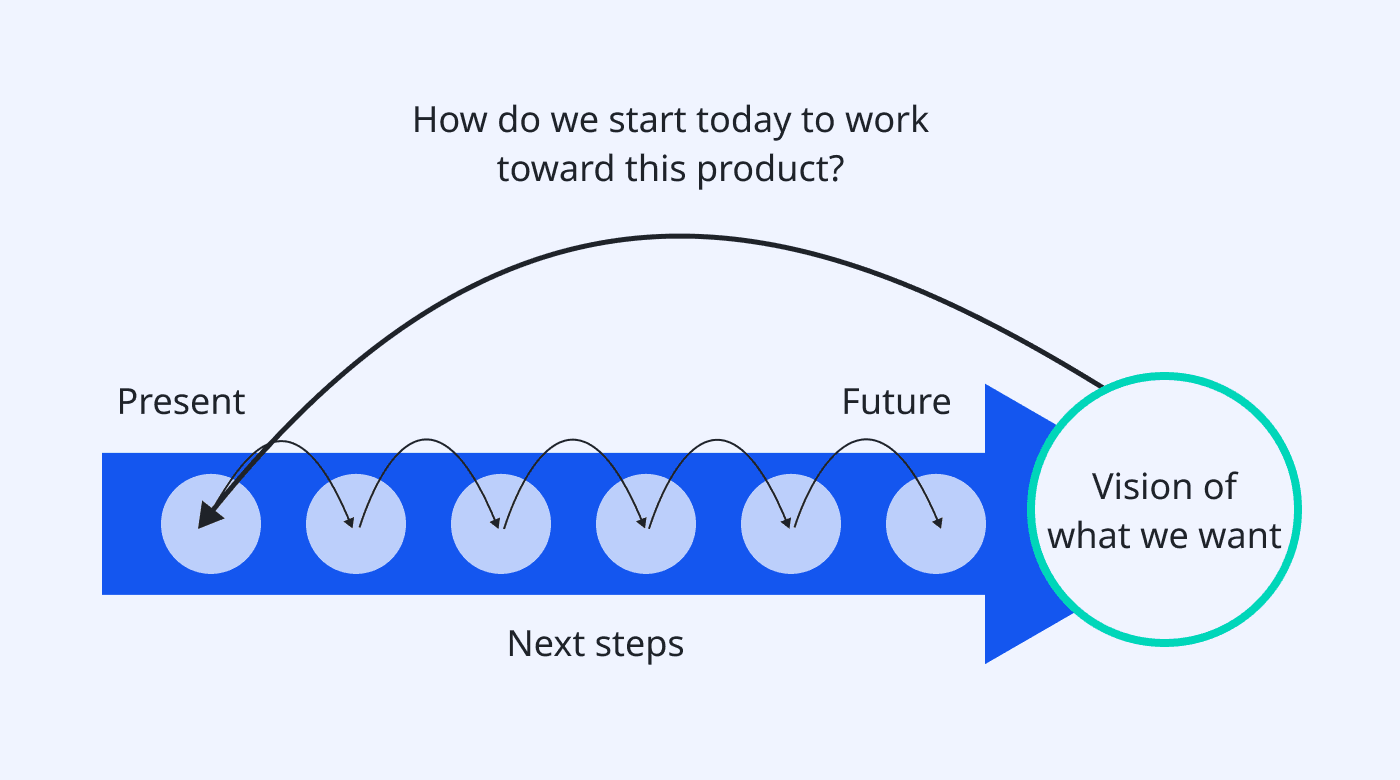
Using the working backwards approach requires the team to address difficult discussions early on. This includes fully understanding the product’s value proposition and how it’ll be presented to the target customers.
The press release acts as a guiding document for the product goal and helps the product team stay aligned on that goal. This also helps prevent scope creep since the scope is defined in the press release and can be referred to throughout the product’s development.
Notably, in the same book that spilled the beans on the PR FAQ, the authors mentioned another useful meeting format called the Amazon 6-pager. This technique helps teams make the most out of their meetings by hashing out 6-page agendas with no filler.
You can also use Lark’s SamePage technique to facilitate meetings. This method puts the whole meeting process in one app, so there’s no need to switch between apps for tasks like scheduling, creating meeting notes, or performing follow-ups.
The limitations of working backwards
The backwards approach isn’t effective for industries with fixed tolerances, such as education, medicine, or finance. For these industries, comprehensive upfront planning using the waterfall method will likely yield better results.
The same goes for creative businesses, like writing or SEO agencies — they typically work better using the PARA method or RAID logs.
Working backwards has the potential to oversimplify the intricacy of learning goals by condensing them into a narrow range of achievable results. It could, therefore, not leave enough room for critical thinking, creativity, and problem-solving.
Furthermore, it can reduce the likelihood that the team will take a risk — not ideal if a risk is just what they need to break into the market.
And then, there’s the challenge of writing a good press release using the working backwards method. Truly putting customer experience first as you design the release is hard work because you need to deeply understand customers’ needs and be willing to scrap any biases you might have.
How to write a press release via the working backwards method
Here’s a step-by-step guide to the press release-writing process via the working backwards method, as well as a template you can use.
Step 1: Use the right layout
Starting with a good layout will save you time and effort. Check out the one below, modeled after the one Amazon uses:
Heading: a user-related title
Logistics: time, date, location
Subheading: a statement describing the advantages for the customer
Summary paragraph: similar to an executive summary or elevator pitch, a brief overview outlining the product’s main value and advantages
Problem paragraph: a description of the potential issue being addressed and the intended audience
Solution paragraph: how the product tackles the key issue described above
Customer quotes: a quote from a hypothetical customer
Getting started: a call to action and/or subsequent steps
You can opt to capture all this information via Lark Docs. With Lark Docs, it’s easy to create your press release and start collaborating right away. You can even use the chat feature to have quick, focused discussions about the PR.
With Lark, you can also create a project database and workspace. All this in one easy-to-use app. As a bonus, it can help you avoid context-switching.
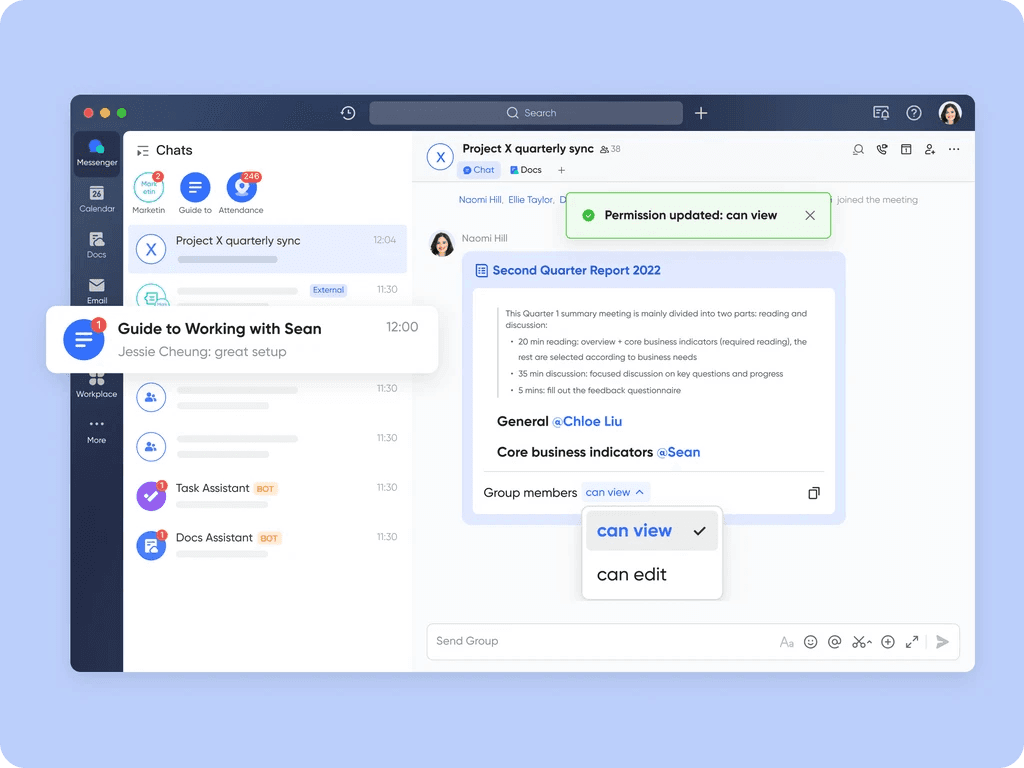
Step 2: Fill in your press release
Copy and paste the example from Step 1 and fill it in or use your own PR template.
To help you visualize this, check out the example below and our tips on how to fill in each section:
Heading:
Master Home Workouts with VirtualFit Pro
Make your title captivating and speak to your audience.
Logistics:
Release early in Q3 2024 on Amazon, eBay, and Alibaba
Add your timeline.
Subheading:
VirtualFit Pro offers personalized workouts and nutrition guides from anywhere.
Mention what to expect in another heading.
Summary paragraph:
VirtualFit Pro is an app that combines your personal trainer, nutritionist, and music selectors into one. It can create tailored workouts based on your fitness level and goals. Plus, you can use it anytime and anywhere.
Write an elevator pitch that summarizes the product release concisely.
Problem paragraph:
Traditional home workouts lack coaching in training, nutrition, and motivation. People want the personal trainer experience without the trainer and with the ability to do it anywhere.
Go over the problem that the product is trying to solve.
Solution paragraph:
VirtualFit Pro offers a virtual personal training experience. It uses AI to create personalized workout plans, meals, and daily playlists.
Detail the solution to the problem.
Customer quotes:
“As a busy person who works, studies part-time, and has three children, I can say that VirtualFit Pro has really helped me with my fitness goals. I don’t have much time to go to the gym, so I have to work out whenever I have a free moment in my schedule. The suggested workouts and virtual playlists keep me motivated, and I've already seen great progress in just a few weeks!” — Emily, VirtualFit Pro user.
Come up with a quote detailing how a satisfied customer might review the product.
Getting started:
Get your own AI personal trainer with VirtualFit Pro
Hook your users with the CTA. Make sure it inspires action and speaks to them.
This is what the example above would look like written out in full:
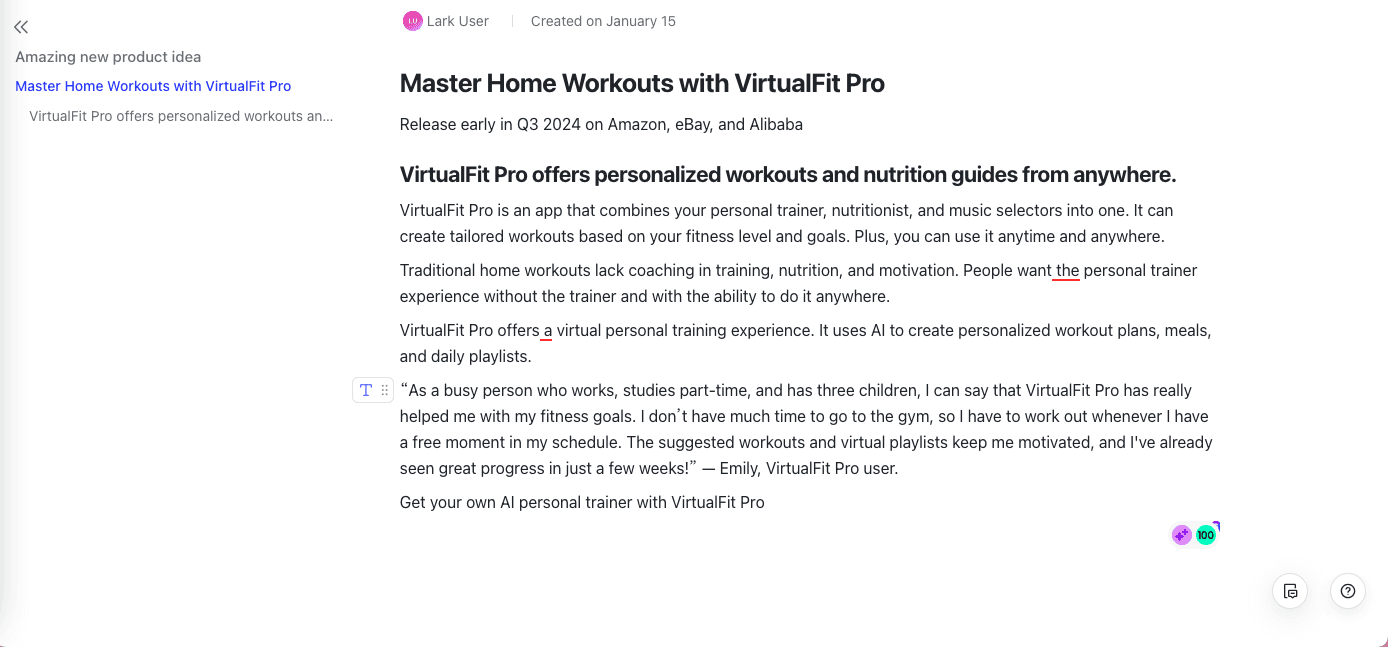
With Lark Docs, you can easily share your press release with your entire product team. You can even start a chat chain with your team to gather their feedback quickly.
Once the product is approved, you can create an Agile project management workspace with Lark (called a Larkspace), where you can write out your development plan and list the tasks, deadlines, and responsibilities.
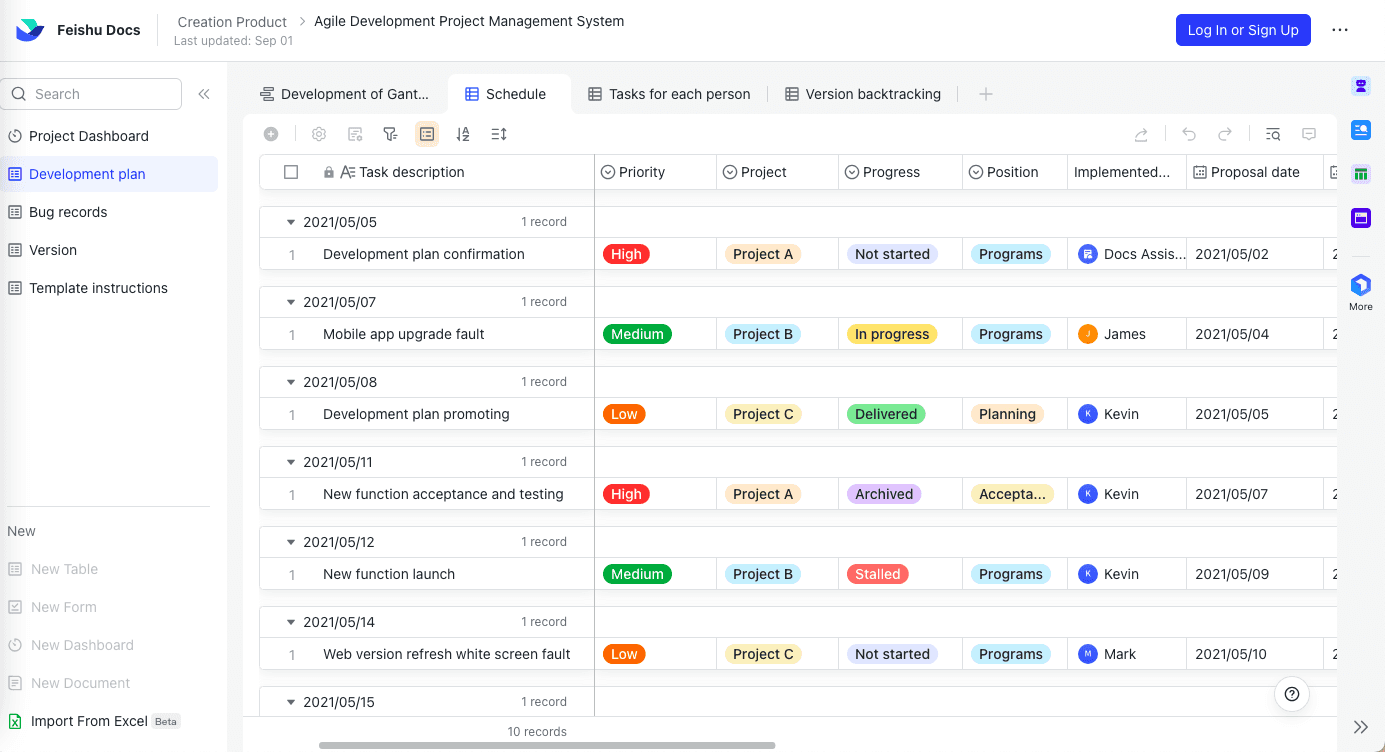
Step 3: Create your FAQs
Once you have the initial sections of the press release ready, you can start building your FAQ section. You can use these FAQs to discover other features customers might find valuable and gauge the potential market fit for your hypothetical product.
There are two types of FAQs:
External FAQs (questions from future clients or customers)
Internal FAQs (questions from teams and functional stakeholders)
For each question, think of an answer that these individuals would give pertaining to the actual product. It’s important to be realistic here.
For the external FAQs, think about what your potential customers might ask about the finished product. For example, with the VirtualFit Pro, they might ask the following:
What’s the price?
How do I get a VirtualFit Pro?
Will the VirtualFit Pro be available everywhere?
How does the VirtualFit Pro work?
For internal FAQs, ask things like:
Is the market sizable?
Is there a genuine demand from customers?
What is the estimated cost and potential return on investment?
Is this strategy likely to be successful?
Put the working backwards approach into action with Lark
Product managers and teams can use Lark to help them draft and put into action press releases using the working backwards method. In addition, you can use Lark’s project workspace to monitor the progress of your products.
















